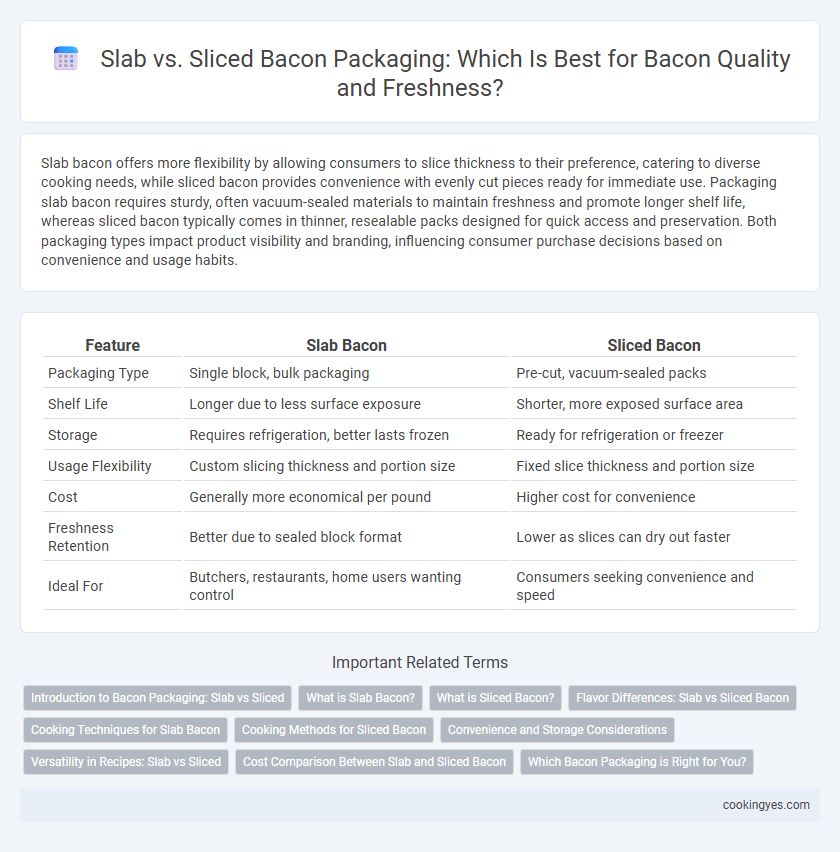Slab bacon offers more flexibility by allowing consumers to slice thickness to their preference, catering to diverse cooking needs, while sliced bacon provides convenience with evenly cut pieces ready for immediate use. Packaging slab bacon requires sturdy, often vacuum-sealed materials to maintain freshness and promote longer shelf life, whereas sliced bacon typically comes in thinner, resealable packs designed for quick access and preservation. Both packaging types impact product visibility and branding, influencing consumer purchase decisions based on convenience and usage habits.
Table of Comparison
| Feature | Slab Bacon | Sliced Bacon |
|---|---|---|
| Packaging Type | Single block, bulk packaging | Pre-cut, vacuum-sealed packs |
| Shelf Life | Longer due to less surface exposure | Shorter, more exposed surface area |
| Storage | Requires refrigeration, better lasts frozen | Ready for refrigeration or freezer |
| Usage Flexibility | Custom slicing thickness and portion size | Fixed slice thickness and portion size |
| Cost | Generally more economical per pound | Higher cost for convenience |
| Freshness Retention | Better due to sealed block format | Lower as slices can dry out faster |
| Ideal For | Butchers, restaurants, home users wanting control | Consumers seeking convenience and speed |
Introduction to Bacon Packaging: Slab vs Sliced
Slab bacon refers to a whole, uncut piece of bacon, allowing consumers to slice it to their preferred thickness, which is ideal for customized cooking needs and freshness preservation. Sliced bacon comes pre-cut into uniform strips, offering convenience and consistent portioning for quick meal preparation and commercial use. Packaging choices impact shelf life, texture, and customer experience, with vacuum-sealed options commonly used to maintain quality in both slab and sliced bacon.
What is Slab Bacon?
Slab bacon refers to large, uncut sections of pork belly that retain the entire muscle and fat layers, offering maximum freshness and flavor customization for consumers. Unlike pre-sliced bacon, slab bacon allows users to cut slices to their preferred thickness, preserving texture and taste during packaging and storage. Packaging slab bacon typically involves vacuum sealing to maintain quality and extend shelf life while providing flexibility for culinary use.
What is Sliced Bacon?
Sliced bacon consists of thin, uniform strips cut from a cured and smoked pork belly, designed for quick and even cooking. This format offers convenience and consistent portion control, making it ideal for retail packaging and consumer use. Sliced bacon maintains flavor and texture while enabling easy storage and portioning compared to slab bacon.
Flavor Differences: Slab vs Sliced Bacon
Slab bacon retains a thicker cut and is often cured and smoked in large pieces, resulting in a more intense, concentrated smoky flavor and a chewier texture after cooking. Sliced bacon, pre-cut into thin strips, tends to cook faster and offers a more uniform, mild flavor profile due to increased surface area exposure to heat. Flavor differences between slab and sliced bacon also arise from seasoning penetration, with slab bacon absorbing curing ingredients more deeply, enhancing its depth and complexity.
Cooking Techniques for Slab Bacon
Slab bacon requires manual slicing, offering thicker cuts that retain more fat and flavor, ideal for slow cooking techniques such as pan-frying or oven roasting to render fat evenly and achieve a crisp texture. It allows precise thickness control, enhancing versatility in recipes like homemade bacon lardons or hearty breakfast dishes. Cooking slab bacon also helps lock in juices, providing richer taste profiles compared to uniformly sliced options commonly found in pre-packaged bacon.
Cooking Methods for Sliced Bacon
Sliced bacon is ideal for frying, baking, and microwaving due to its uniform thickness, allowing even cooking and crispiness. Its pre-cut form ensures quick heat penetration, making it perfect for recipes like bacon-wrapped appetizers or breakfast dishes requiring precise portion control. Compared to slab bacon, sliced bacon offers more convenience and consistency in cooking times and texture.
Convenience and Storage Considerations
Slab bacon offers greater flexibility for portioning and cooking preferences, allowing consumers to cut the desired thickness, which is ideal for customized meal preparation. Sliced bacon provides convenience with pre-measured portions that save time during cooking and fit easily into standard storage containers or refrigerator spaces. When considering storage, slab bacon typically requires more space due to its larger, uncut format, whereas sliced bacon is compact and often sold in resealable packaging that helps maintain freshness.
Versatility in Recipes: Slab vs Sliced
Slab bacon offers greater versatility in recipes by allowing cooks to customize thickness and cut style, perfect for dishes requiring specific bacon textures such as lardons or pancetta. Sliced bacon provides convenience and consistency, ideal for quick preparation of crispy strips or sandwiches. Choosing slab or sliced bacon depends on the desired recipe flexibility and cooking method preferences.
Cost Comparison Between Slab and Sliced Bacon
Slab bacon generally costs less per pound compared to sliced bacon due to lower processing and packaging expenses. Bulk packaging of slab bacon reduces labor and machinery costs, resulting in more affordable pricing for consumers. Sliced bacon incurs higher costs because of additional slicing, layering, and individual packaging requirements that increase production complexity.
Which Bacon Packaging is Right for You?
Slab bacon offers flexibility for those who prefer customizing slice thickness and thickness, making it ideal for gourmet cooking and precise portion control. Sliced bacon provides convenience and speed, perfect for busy households or commercial kitchens requiring consistent, ready-to-cook strips. Selecting between slab and sliced bacon packaging depends on your cooking style, storage preferences, and the level of control you want over each slice.
Slab vs Sliced for Bacon Packaging Infographic

 cookingyes.com
cookingyes.com